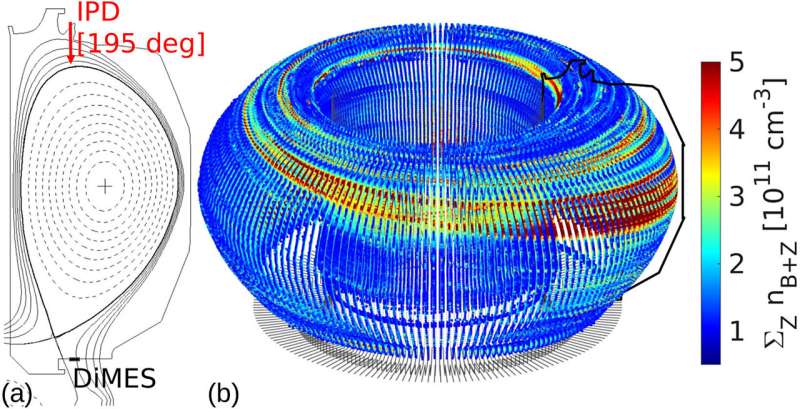
Future tokamak fusion power reactors will generate heat beyond what current materials can withstand. Scientists have proposed various methods for cooling the edge of the magnetically confined fusion fuel, or plasma, to protect the walls of the surrounding tokamak. One approach is injecting impurities in the form of gases to help radiate away excess heat. However, there is a limited range of gases that can be injected, and some gases react poorly with hydrogen fusion fuel.
A new approach uses impurities in powder form. This allows researchers to introduce a considerable amount of material directly into the exhaust system, far more than with any gas injection technique. This leads to a promising scenario that reduces peak heat fluxes that reach the tokamak wall.
Uniform radiation is important for a particular region of the tokamak called the divertor. This region exhausts concentrated heat and particles, then experiences potentially damaging heat fluxes. Plant operators can inject impurities to absorb heat from these particles and release it instead as light. This cools the plasma edge, creating a protective gas cushion that helps spread heat and particles uniformly across the divertor.
The use of powders in place of gases expands the range of possible impurities that can be injected into a tokamak. Powders can also be delivered in higher purity than gases, reducing the dilution of fuel and allowing better control of the fusion plasma. However, powder delivery is still relatively slow, and researchers will need to improve these methods to react to changes in plasma conditions.
Future work will combine powder injection for exhaust control with optimization of fusion performance in the plasma core. These steps will help fusion scientists demonstrate how these methods would operate in a working fusion reactor.
Summary
Typical tokamak impurity injection methods employ gases such as nitrogen. While the use of gas simplifies the introduction of impurities into the plasma, the range of appropriate gases is limited, and these gases often react detrimentally with the hydrogen fuel. A research team working at the DIII-D National Fusion Facility, a Department of Energy (DOE) user facility, experimented with the injection of boron, boron nitride, and lithium powders. Lithium in particular is attractive due to its potential use as a candidate for proposed liquid metal walls in future tokamaks, which would allow heat to spread and be conducted away efficiently and safely.
During the experiments, measurements showed increased light emission (radiation) and associated reductions in peak heat flux reaching the wall surfaces. At the same time, powder injection improved the wall conditions and reduced the fuel dilution through impurities. Both lithium and boron nitride caused a substantial increase in gas pressure at the divertor.
The radiation features and distribution observed during powder injection were also seen in computer simulations modeling the experiment. The simulations showed that materials with smaller particle sizes tend to be ablated immediately at the injection location and migrate similar to a gas. Larger particles can travel longer distances before they are fully ablated and ionized.
The simulations show that the choice of the material and particle size allows controlling the deposition and the location of the cooling location. Understanding this effect in the experiments and through computer simulations makes it possible to include this in reactor designs. Incorporating powder injection into future reactor designs may allow them to maintain high levels of fusion performance while increasing the lifetime of divertor surfaces.
The details of these experiments were published in Nuclear Materials and Energy.
F. Effenberg et al, 3D modeling of boron transport in DIII-D L-mode wall conditioning experiments, Nuclear Materials and Energy (2021). DOI: 10.1016/j.nme.2021.100900
Citation:
Blowing dust to cool fusion plasmas (2022, March 8)
retrieved 8 March 2022
from https://techxplore.com/news/2022-03-cool-fusion-plasmas.html
This document is subject to copyright. Apart from any fair dealing for the purpose of private study or research, no
part may be reproduced without the written permission. The content is provided for information purposes only.
Stay connected with us on social media platform for instant update click here to join our Twitter, & Facebook
We are now on Telegram. Click here to join our channel (@TechiUpdate) and stay updated with the latest Technology headlines.
For all the latest Technology News Click Here
For the latest news and updates, follow us on Google News.
